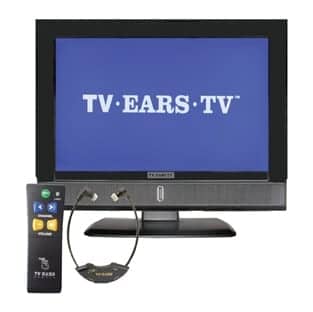Unlike many hearing configurations that started in the 1960s, so-called “loop” technology is still around, and it’s still viable. Audiology veterans will recall that loops often circled the living rooms of hearing-impaired individuals. Those days are back.
Earlier this year, officials at Spring Valley, Calif-based TV Ears decided to use loop technology in conjunction with the venerable T-coil, which can still be found in the majority of hearing aids. To take advantage of the relatively old technology, TV Ears is offering what it bills as the first “senior friendly” television—a 32-inch high-definition unit complete with all the required equipment.

|
| TV Ears’ senior-friendly HDTV system introduced earlier this year |
TV Ears’ CEO George Dennis is hoping the new device will add another listening option for consumers, and a viable business opportunity for audiology practices. “We attach this loop to the back of the television, and you run this little wire all around the seating area or the room that the person is watching TV in,” explains Dennis, who cofounded TV Ears more than a dozen years ago. “The sound of the TV goes in the loop, and when you hit the T-coil, the sound goes into your hearing aid.”
Whatever sound is going into the loop ultimately goes into the hearing aid when the coil is activated. Now hearing aid users can effectively shut out the considerable ambient noise and lock onto the broadcast without having to switch over to the classic TV Ears. “Our first push is to put these in the waiting rooms of hearing professionals,” comments Dennis. “If you are an audiologist, my question is ‘Why don’t you have your waiting room looped?’ If you go to the United Kingdom, they have everything looped—banks, McDonald’s, everything. If I can order a cheeseburger through a UK loop system, why wouldn’t you have one in your audiology office?”
Dennis believes a TV in the waiting room, or perhaps a nearby conference room, is a great way to ultimately sell more hearing aids. “I’ve seen the look on people’s faces when they buy hearing aids, and they are usually not that excited about it,” muses Dennis. “But if dad can hear the basketball game in his hearing aid, it could be a little bit more satisfying for him. Audiologists can service their patients better, sell more hearing aids, and let people experience this really cool technology.”
SUCCESSFUL PITCH
Getting potential customers to experience the “really cool” nature of a product is not always easy, but for Ken Freia, owner of Advanced Quality Hearing Systems, Pompano Beach, Fla, it helps to be located in a mall with heavy foot traffic. Freia pays an employee to stand out in front with a TV Ears in hand where people can take about 20 seconds to try on the product.
Remaining in the same location since 2002 means a lot of people have passed by and told friends about the store and its products. After using TV commercials, newspaper ads, and radio spots, Freia now relies almost exclusively on crucial word of mouth, and a talkative employee engaging passersby in a good-natured and fun manner.
One of the keys to a successful pitch is to ask the right question. For example, Freia advises never to ask customers if they would like to try TV Ears. Instead, ask, “Have you ever tried TV Ears?” If they happen to say “Yes,” then respond by saying, “Great, do you have a pair at home or do you use them at the movies?” Before this banter dies down, the unit is already resting on the customer’s ears, usually eliciting a smile of recognition and sowing the seeds of yet another sale.
The cost for the loop-system television is $795 (price for authorized gold dealers), which includes the wireless headset, remote control, delivery, and installation. The turnkey nature of the service can be applied to the professional setting or the consumer home. If and when customers express interest in the loop system, audiologists can leave the installation and setup to TV Ears.
It’s not unreasonable, predicts Dennis, to expect a sales jump of perhaps two more sets of hearing aids per month, a boost that the CEO says has already been realized by audiologists since TV Ears began offering the system at the beginning of this year. Since a hearing aid can sell for upwards of $5,000, that’s the potential of an extra $10,000 per month, and a whopping $120,000 per year.
If hearing aid users want a loop system and a traditional TV Ears on the same TV, it is not a problem. “If customers do not want to wear their hearing aid, the beauty of TV Ears is you get the same great amplification without the need to own or wear a hearing aid,” adds Dennis. “We are trying to provide every conceivable option for TV listening. The TV head set is universally accepted across all customer demographics, and the loop is a great adjunct that you can put on your TV for those people who have a hearing aid and have it T-coil enabled.”

|
| TV Ears CEO George Dennis |
BACK IN THE LOOP
Kenneth E. Smith, PhD, vice president of the Hearing Center of Castro Valley, Castro Valley, Calif, has sold a lot of TV Ears over the years. However, the industry veteran had essentially given up on using loops a long time ago because he viewed them as inefficient for television listening. When Smith saw TV Ears’ loop-system TV demonstration at this year’s AudiologyNow! Conference in San Diego, he changed his mind.
After deciding to carry the product, Smith decided to show it off in a conference room where he also performs patient education and orientation.
“The beauty of this system is that the new TV Ears TV has the broadcasting unit built directly into it so people can pick up a receiver in the room, stick it in their ears, and hear it through the TV,” says Smith, who has been in practice more than 30 years. “Or if they have a T-coil, the room is looped, and it is looped above the ceiling so it is not around the baseboards that would be in somebody’s home. If they have T-coil settings on their hearing aids, it’s a perfect time to demonstrate it because all they do is turn it to T and they are directly into the TV. If they don’t want the loop at home, the other great thing is you can use a neck loop with the T-coil.”
Since Smith could not get cable TV in his building, he uses DVDs to demonstrate the clarity to new patients. “The system would work exactly the same way in a waiting room if you wanted to do that,” adds Smith. “In our waiting room, we don’t keep people waiting, and it just wasn’t worth the bang for the buck to put it out there. We have it in a place where we are already talking about assistive devices.”
Unlike Freia, Smith does not rely on a prime location to snare new customers. However, he and Freia benefit from crucial word-of-mouth advertising and Web-based marketing. “We also have a large customer base and get a lot of medical referrals,” says Smith. “We don’t do much advertising, print or otherwise. We have a newsletter that goes out and has a blurb in it this time on the TV Ears TV system, so we have a ready population of people that know us. During our interview with new customers, one of the big things we hear is that enjoying the TV is a big priority. Having this product and technology is going to be a fantastic step forward.”
Feeling the benefits in the revenue department is something that George Dennis believes is well within the grasp of many audiologists. In the past, the TV Ears CEO admits that some hearing aid dispensers felt threatened by TV Ears. With the new loop system, those concerns are gone.
“The loop configuration fits hand and glove with the hearing aid business, because you are selling hearing aids,” says Dennis. “If I were an audiologist, I would want to sell you a TV with a loop, and a hearing aid with a T-coil. Or at least if you own your own TV, and you like it, I’ll sell you the loop with a hearing aid and T-coil.”
Whether customers purchase the system directly from TV Ears, or through an audiology practice, Dennis hopes the new loop system can boost overall customer satisfaction, and perhaps even improve the 20% rate of return. “People spend $5,000 to $6,000 on hearing aids and they get home and they are not everything they are cracked up to be,” says Dennis. “So I do believe that the loop and the use of the hearing aids for watching TV can reduce returns as well.”
“The prices on these are very reasonable,” adds Smith. “Especially when you look at the HDTV you get, plus the installation and the TV Ears TV setup. I was amazed, and I think patients will be too, particularly when they start pricing TVs to see what they are getting.”
Greg Thompson is a contributing writer to Hearing Review Products. He can be reached via Editor Will Campbell at [email protected]





